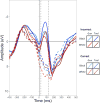Using trial-level data and multilevel modeling to investigate within-task change in event-related potentials
- PMID: 29226966
- PMCID: PMC5899682
- DOI: 10.1111/psyp.13044
Using trial-level data and multilevel modeling to investigate within-task change in event-related potentials
Abstract
EEG data, and specifically the ERP, provide psychologists with the power to examine quickly occurring cognitive processes at the native temporal resolution at which they occur. Despite the advantages conferred by ERPs to examine processes at different points in time, ERP researchers commonly ignore the trial-to-trial temporal dimension by collapsing across trials of similar types (i.e., the signal averaging approach) because of constraints imposed by repeated measures ANOVA. Here, we present the advantages of using multilevel modeling (MLM) to examine trial-level data to investigate change in neurocognitive processes across the course of an experiment. Two examples are presented to illustrate the usefulness of this technique. The first demonstrates decreasing differentiation in N170 amplitude to faces of different races across the course of a race categorization task. The second demonstrates attenuation of the ERN as participants commit more errors within a task designed to measure implicit racial bias. Although the examples presented here are within the realm of social psychology, the use of MLM to analyze trial-level EEG data has the potential to contribute to a number of different theoretical domains within psychology.
Keywords: ERPs; analysis/statistical methods; error processing; face processing.
© 2017 Society for Psychophysiological Research.
Figures





References
-
- Aiken LS, West SG. Multiple regressions: Testing and interpreting interactions. Newbury Park, CA: Sage Publications; 1991.
-
- Alday PM, Schlesewsky M, Bornkessel-Schlesewsky I. Towards a computational model of actor-based language comprehension. Neuroinformatics. 2014;12(1):143–179. https://doi.org/10.1007/s12021-013-9198-x. - DOI - PubMed
-
- American Clinical Neurophysiology Society. Guideline 5: Guidelines for standard electrode position nomenclature. Journal of Clinical Neurophysiology. 2006;23(2):107–110. - PubMed
-
- Baayen RH, Davidson DJ, Bates DM. Mixed-effects modeling with crossed random effects for subjects and items. Journal of Memory and Language. 2008;59(4):390–412. https://doi.org/10.1016/j.jml.2007.12.005. - DOI
-
- Bailey K, Bartholow BD, Saults JS, Lust SA. Give me just a little more time: Effects of alcohol on the failure and recovery of cognitive control. Journal of Abnormal Psychology. 2014;123(1):152–167. https://doi.org/10.1037/a0035662. - DOI - PMC - PubMed
Publication types
MeSH terms
Grants and funding
LinkOut - more resources
Full Text Sources
Other Literature Sources

